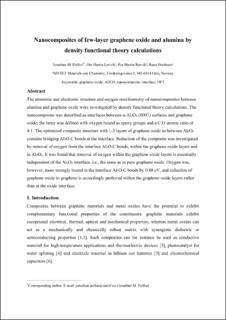| dc.contributor.author | Polfus, Jonathan M. | |
| dc.contributor.author | Løvvik, Ole Martin | |
| dc.contributor.author | Rørvik, Per Martin | |
| dc.contributor.author | Bredesen, Rune | |
| dc.date.accessioned | 2020-12-21T13:15:59Z | |
| dc.date.available | 2020-12-21T13:15:59Z | |
| dc.date.created | 2016-02-12T16:30:40Z | |
| dc.date.issued | 2016 | |
| dc.identifier.citation | Journal of the European Ceramic Society. 2016, 36 (3), 719-724. | en_US |
| dc.identifier.issn | 0955-2219 | |
| dc.identifier.uri | https://hdl.handle.net/11250/2720613 | |
| dc.description.abstract | The atomistic and electronic structure and oxygen stoichiometry of nanocomposites between alumina and graphene oxide were investigated by density functional theory calculations. The nanocomposite was described as interfaces between α-Al2O3 (0001) surfaces and graphene oxide; the latter was defined with oxygen bound as epoxy groups and a C:O atomic ratio of 4:1. The optimized composite structure with 1–3 layers of graphene oxide in between Al2O3 contains bridging Alsingle bondOsingle bondC bonds at the interface. Reduction of the composite was investigated by removal of oxygen from the interface Alsingle bondOsingle bondC bonds, within the graphene oxide layers and in Al2O3. It was found that removal of oxygen within the graphene oxide layers is essentially independent of the Al2O3 interface, i.e., the same as in pure graphene oxide. Oxygen was, however, more strongly bound in the interface Alsingle bondOsingle bondC bonds by 0.80 eV, and reduction of graphene oxide to graphene is accordingly preferred within the graphene oxide layers rather than at the oxide interface. | en_US |
| dc.language.iso | eng | en_US |
| dc.publisher | Elsevier | en_US |
| dc.rights | Attribution-NonCommercial-NoDerivatives 4.0 Internasjonal | * |
| dc.rights.uri | http://creativecommons.org/licenses/by-nc-nd/4.0/deed.no | * |
| dc.subject | DFT | en_US |
| dc.subject | Interface | en_US |
| dc.subject | Nanocomposite | en_US |
| dc.subject | Al2O3 | en_US |
| dc.subject | Graphene oxide | en_US |
| dc.title | Nanocomposites of few-layer graphene oxide and alumina by density functional theory calculations | en_US |
| dc.type | Peer reviewed | en_US |
| dc.type | Journal article | en_US |
| dc.description.version | acceptedVersion | en_US |
| dc.rights.holder | This is the authors’ accepted and refereed manuscript to the article.This manuscript version is made available under the CC-BY-NC-ND 4.0 license. DOI: https://doi.org/10.1016/j.jeurceramsoc.2015.11.009 | en_US |
| dc.source.pagenumber | 719-724 | en_US |
| dc.source.volume | 36 | en_US |
| dc.source.journal | Journal of the European Ceramic Society | en_US |
| dc.source.issue | 3 | en_US |
| dc.identifier.doi | 10.1016/j.jeurceramsoc.2015.11.009 | |
| dc.identifier.cristin | 1335498 | |
| dc.relation.project | Notur/NorStore: nn9259k | en_US |
| dc.relation.project | Notur/NorStore: NN2615K | en_US |
| cristin.unitcode | 7401,80,3,2 | |
| cristin.unitcode | 7401,80,6,2 | |
| cristin.unitcode | 7401,80,3,0 | |
| cristin.unitname | Tynnfilm og membranteknologi | |
| cristin.unitname | Materialfysikk. Oslo | |
| cristin.unitname | Bærekraftig energiteknologi | |
| cristin.ispublished | true | |
| cristin.fulltext | postprint | |
| cristin.qualitycode | 1 | |

